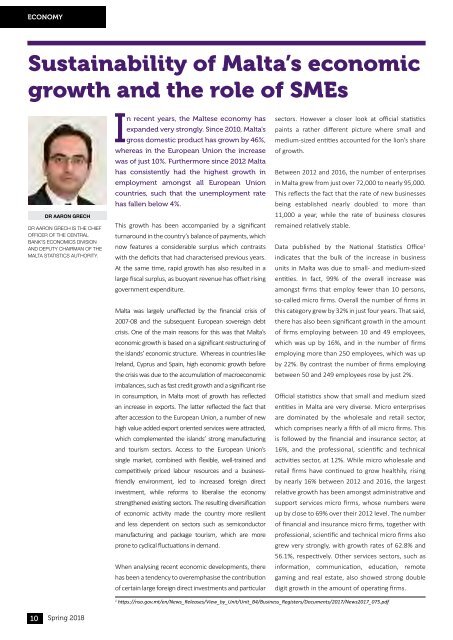ACCSPRING18_ONLINEVER
Create successful ePaper yourself
Turn your PDF publications into a flip-book with our unique Google optimized e-Paper software.
ECONOMY<br />
Sustainability of Malta’s economic<br />
growth and the role of SMEs<br />
DR AARON GRECH<br />
DR AARON GRECH IS THE CHIEF<br />
OFFICER OF THE CENTRAL<br />
BANK’S ECONOMICS DIVISION<br />
AND DEPUTY CHAIRMAN OF THE<br />
MALTA STATISTICS AUTHORITY.<br />
In recent years, the Maltese economy has<br />
expanded very strongly. Since 2010, Malta’s<br />
gross domestic product has grown by 46%,<br />
whereas in the European Union the increase<br />
was of just 10%. Furthermore since 2012 Malta<br />
has consistently had the highest growth in<br />
employment amongst all European Union<br />
countries, such that the unemployment rate<br />
has fallen below 4%.<br />
This growth has been accompanied by a significant<br />
turnaround in the country’s balance of payments, which<br />
now features a considerable surplus which contrasts<br />
with the deficits that had characterised previous years.<br />
At the same time, rapid growth has also resulted in a<br />
large fiscal surplus, as buoyant revenue has offset rising<br />
government expenditure.<br />
Malta was largely unaffected by the financial crisis of<br />
2007-08 and the subsequent European sovereign debt<br />
crisis. One of the main reasons for this was that Malta’s<br />
economic growth is based on a significant restructuring of<br />
the islands’ economic structure. Whereas in countries like<br />
Ireland, Cyprus and Spain, high economic growth before<br />
the crisis was due to the accumulation of macroeconomic<br />
imbalances, such as fast credit growth and a significant rise<br />
in consumption, in Malta most of growth has reflected<br />
an increase in exports. The latter reflected the fact that<br />
after accession to the European Union, a number of new<br />
high value added export oriented services were attracted,<br />
which complemented the islands’ strong manufacturing<br />
and tourism sectors. Access to the European Union’s<br />
single market, combined with flexible, well-trained and<br />
competitively priced labour resources and a businessfriendly<br />
environment, led to increased foreign direct<br />
investment, while reforms to liberalise the economy<br />
strengthened existing sectors. The resulting diversification<br />
of economic activity made the country more resilient<br />
and less dependent on sectors such as semiconductor<br />
manufacturing and package tourism, which are more<br />
prone to cyclical fluctuations in demand.<br />
When analysing recent economic developments, there<br />
has been a tendency to overemphasise the contribution<br />
of certain large foreign direct investments and particular<br />
sectors. However a closer look at official statistics<br />
paints a rather different picture where small and<br />
medium-sized entities accounted for the lion’s share<br />
of growth.<br />
Between 2012 and 2016, the number of enterprises<br />
in Malta grew from just over 72,000 to nearly 95,000.<br />
This reflects the fact that the rate of new businesses<br />
being established nearly doubled to more than<br />
11,000 a year, while the rate of business closures<br />
remained relatively stable.<br />
Data published by the National Statistics Office 1<br />
indicates that the bulk of the increase in business<br />
units in Malta was due to small- and medium-sized<br />
entities. In fact, 99% of the overall increase was<br />
amongst firms that employ fewer than 10 persons,<br />
so-called micro firms. Overall the number of firms in<br />
this category grew by 32% in just four years. That said,<br />
there has also been significant growth in the amount<br />
of firms employing between 10 and 49 employees,<br />
which was up by 16%, and in the number of firms<br />
employing more than 250 employees, which was up<br />
by 22%. By contrast the number of firms employing<br />
between 50 and 249 employees rose by just 2%.<br />
Official statistics show that small and medium sized<br />
entities in Malta are very diverse. Micro enterprises<br />
are dominated by the wholesale and retail sector,<br />
which comprises nearly a fifth of all micro firms. This<br />
is followed by the financial and insurance sector, at<br />
16%, and the professional, scientific and technical<br />
activities sector, at 12%. While micro wholesale and<br />
retail firms have continued to grow healthily, rising<br />
by nearly 16% between 2012 and 2016, the largest<br />
relative growth has been amongst administrative and<br />
support services micro firms, whose numbers were<br />
up by close to 69% over their 2012 level. The number<br />
of financial and insurance micro firms, together with<br />
professional, scientific and technical micro firms also<br />
grew very strongly, with growth rates of 62.8% and<br />
56.1%, respectively. Other services sectors, such as<br />
information, communication, education, remote<br />
gaming and real estate, also showed strong double<br />
digit growth in the amount of operating firms.<br />
1<br />
https://nso.gov.mt/en/News_Releases/View_by_Unit/Unit_B4/Business_Registers/Documents/2017/News2017_075.pdf<br />
10 Spring 2018

















